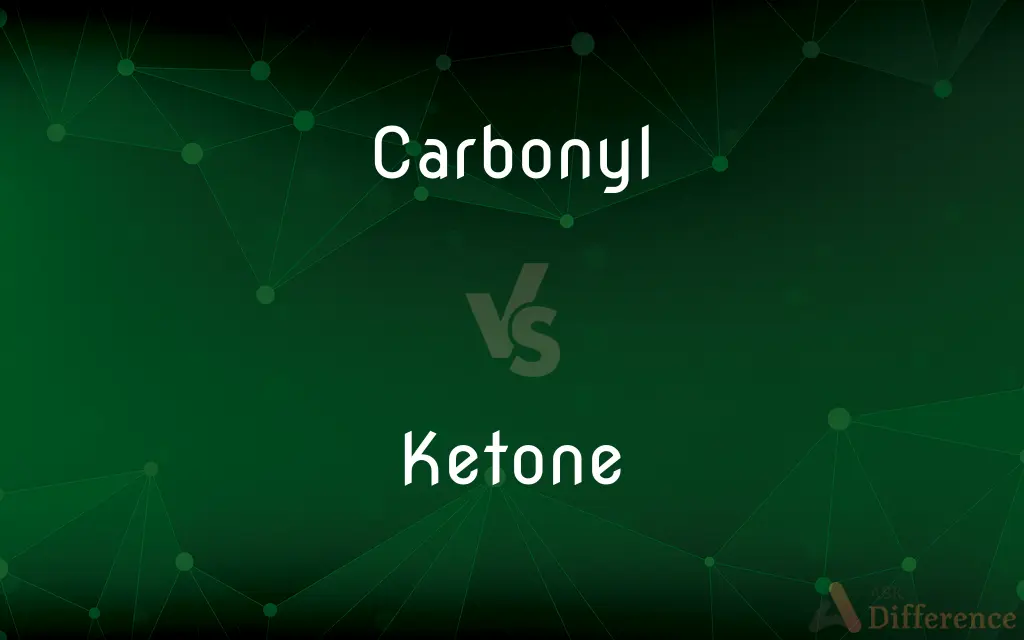Carbonyl vs. Ketone — What's the Difference?
Edited by Tayyaba Rehman — By Fiza Rafique — Updated on October 11, 2023
Carbonyl is a functional group characterized by a carbon atom double-bonded to an oxygen atom (C=O). Ketones are organic compounds containing a carbonyl group bonded to two alkyl or aryl groups.

Difference Between Carbonyl and Ketone
Table of Contents
ADVERTISEMENT
Key Differences
The term "carbonyl" refers to a specific functional group in organic chemistry, characterized by a carbon atom double-bonded to an oxygen atom. The presence of a carbonyl group can be found in various types of compounds. Ketone, meanwhile, specifically refers to a subset of carbonyl-containing compounds where the carbonyl carbon is bonded to two other carbon atoms.
Carbonyl groups are pervasive in organic molecules and serve as a hallmark for several compound classes. For instance, besides ketones, aldehydes, carboxylic acids, and amides all contain a carbonyl group. Ketones, on the other hand, are distinguished by having the carbonyl carbon bonded specifically to two other carbons, without any hydrogen directly attached.
The properties of molecules often derive from their functional groups. The carbonyl group, due to its polar nature, can partake in a variety of reactions, especially nucleophilic addition. Ketones, possessing the carbonyl group, share many of these reactivity patterns but can also exhibit unique behaviors due to their specific structure.
In terms of detection and analysis, various methods target the carbonyl group. Spectroscopic techniques, for example, can identify the presence of a carbonyl function. Ketones, being a subset of carbonyl compounds, will exhibit these characteristic signatures but can also be differentiated from other carbonyls by further analysis.
To sum it up, while every ketone will contain a carbonyl group, the reverse isn't true. The term "carbonyl" is broader, encompassing a wider range of compounds than "ketone."
ADVERTISEMENT
Comparison Chart
Definition
Functional group (C=O)
Compound with a carbonyl bonded to two carbon atoms
Occurrence
Found in various compound types
Specific type of carbonyl compound
Bonding
Carbon double-bonded to oxygen
Carbonyl carbon bonded to two other carbons
Examples
Aldehydes, ketones, carboxylic acids
Acetone, butanone
Characteristic
General descriptor for a range of compounds
Specific class of compounds
Compare with Definitions
Carbonyl
A polar group often involved in nucleophilic addition reactions.
Due to its polarity, the carbonyl group is reactive toward nucleophiles.
Ketone
A subset of carbonyl-containing compounds.
While all ketones are carbonyl compounds, not all carbonyls are ketones.
Carbonyl
A functional group with a carbon atom double-bonded to an oxygen atom.
The carbonyl group is a key feature in many organic compounds.
Ketone
An organic compound containing a carbonyl group bonded to two carbon atoms.
Acetone is a simple ketone commonly used as a solvent.
Carbonyl
A central feature in several classes of organic compounds.
Compounds like aldehydes and ketones all contain a carbonyl group.
Ketone
A class of compounds known for their sweet or sharp odors.
Many ketones have distinct, often pleasant fragrances.
Carbonyl
A descriptor for compounds containing the C=O group.
Many reagents specifically target the carbonyl functionality.
Ketone
A molecule with the general formula RC(=O)R', where R and R' can be the same or different alkyl or aryl groups.
Butanone is a ketone where one of the alkyl groups is a propyl chain.
Carbonyl
An electron-withdrawing group affecting nearby atoms.
The presence of a carbonyl can influence the acidity of neighboring hydrogens.
Ketone
In chemistry, a ketone is a functional group with the structure R2C=O, where R can be a variety of carbon-containing substituents. Ketones contain a carbonyl group (a carbon-oxygen double bond).
Carbonyl
The bivalent group C=O.
Ketone
Any of a class of organic compounds, such as acetone, characterized by having a carbonyl group in which the carbon atom is bonded to two other hydrocarbon groups and having the general formula R(CO)R′, where R may be the same as R′.
Carbonyl
A metal compound, such as Ni(CO)4, containing the CO group.
Ketone
See ketone body.
Carbonyl
(organic chemistry) In organic chemistry, a divalent functional group, (-CO-), characteristic of aldehydes, ketones, carboxylic acids, amides, carboxylic acid anhydrides, carbonyl halides, esters and others.
Ketone
(organic compound) A homologous series of organic molecules whose functional group is an oxygen atom joined to a carbon atom—by a double bond—in a carbon-hydrogen based molecule.
Carbonyl
(inorganic chemistry) Any compound of a metal with carbon monoxide, such as nickel carbonyl, Ni(CO)4.
Ketone
One of a large class of organic substances resembling the aldehydes, obtained by the distillation of certain salts of organic acids and consisting of carbonyl (CO) united with two hydrocarbon radicals. In general the ketones are colorless volatile liquids having a pungent ethereal odor.
Carbonyl
The radical (CO)´´, occuring, always combined, in many compounds, as the aldehydes, the ketones, urea, carbonyl chloride, etc.
Ketone
Any of a class of organic compounds having a carbonyl group linked to a carbon atom in each of two hydrocarbon radicals
Carbonyl
A compound containing metal combined with carbon monoxide
Carbonyl
Relating to or containing the carbonyl group
Common Curiosities
What is a carbonyl?
A carbonyl is a functional group in organic chemistry characterized by a carbon atom double-bonded to an oxygen atom (C=O).
What distinguishes a ketone from other carbonyl-containing compounds?
In ketones, the carbonyl carbon is bonded to two other carbon atoms. In other carbonyl compounds, the attachments can differ, like in aldehydes where one bond is to a hydrogen.
How is a ketone defined?
A ketone is an organic compound where the carbonyl group (C=O) is bonded to two carbon atoms.
Are all ketones carbonyls?
Yes, all ketones contain a carbonyl group, but not all carbonyls are found in ketones.
Why are carbonyl compounds reactive?
Carbonyl compounds are polar, making them susceptible to nucleophilic attack. This makes them reactive in many organic reactions.
Do carbonyl groups appear in molecules other than ketones?
Yes, carbonyl groups can also be found in aldehydes, carboxylic acids, esters, and amides, among others.
How can ketones be synthesized in the lab?
One common method is through the oxidation of secondary alcohols using oxidizing agents.
What is the importance of ketones in biology?
Ketones, especially beta-hydroxybutyrate, are vital energy sources during carbohydrate restriction or starvation, like in ketogenic diets.
Can carbonyl compounds be detected spectroscopically?
Yes, carbonyl compounds, including ketones, exhibit a characteristic peak in infrared (IR) spectroscopy.
Are carbonyl groups found in larger biomolecules?
Yes, carbonyl groups are present in many biomolecules, including proteins, nucleic acids, and lipids.
Do ketones have distinct physical properties?
Yes, many ketones have characteristic odors, and they tend to have higher boiling points than similar-sized hydrocarbons due to their polar nature.
What is the general formula for ketones?
The general formula for ketones is RC(=O)R', where R and R' can be the same or different alkyl or aryl groups.
Can ketones act as solvents?
Yes, some ketones, like acetone, are commonly used as industrial solvents due to their ability to dissolve a wide range of substances.
How are ketones named in organic chemistry?
Ketones are typically named by identifying the alkyl or aryl groups attached to the carbonyl and adding the suffix "-one." For instance, propanone.
Is the carbonyl group always located at the end of a molecule?
No, while aldehydes have carbonyls at the end, in ketones and many other carbonyl compounds, the carbonyl can be located internally.
Share Your Discovery

Previous Comparison
Camping vs. Campsite
Next Comparison
Boot vs. KickAuthor Spotlight
Written by
Fiza RafiqueFiza Rafique is a skilled content writer at AskDifference.com, where she meticulously refines and enhances written pieces. Drawing from her vast editorial expertise, Fiza ensures clarity, accuracy, and precision in every article. Passionate about language, she continually seeks to elevate the quality of content for readers worldwide.
Edited by
Tayyaba RehmanTayyaba Rehman is a distinguished writer, currently serving as a primary contributor to askdifference.com. As a researcher in semantics and etymology, Tayyaba's passion for the complexity of languages and their distinctions has found a perfect home on the platform. Tayyaba delves into the intricacies of language, distinguishing between commonly confused words and phrases, thereby providing clarity for readers worldwide.














































